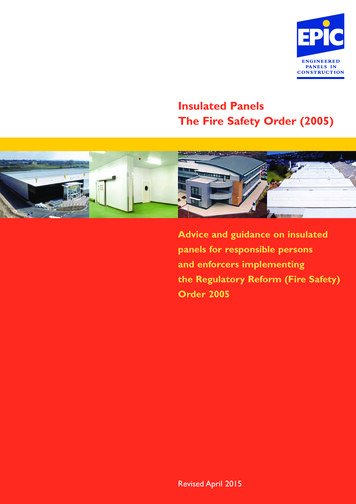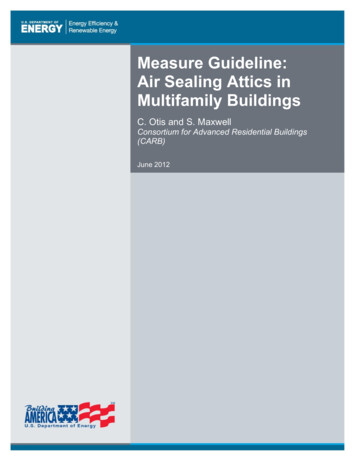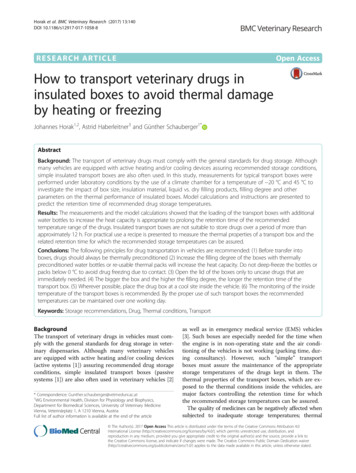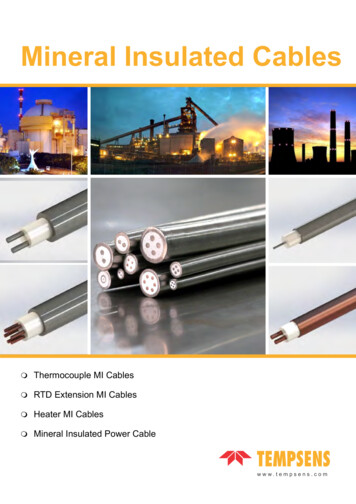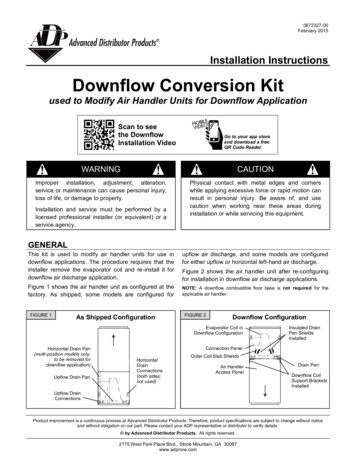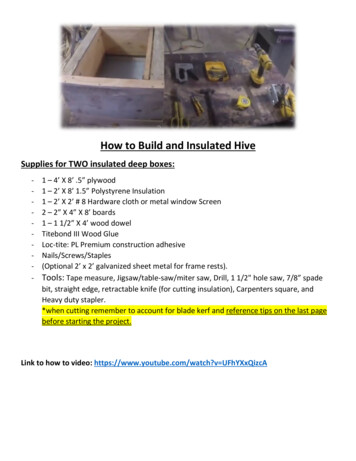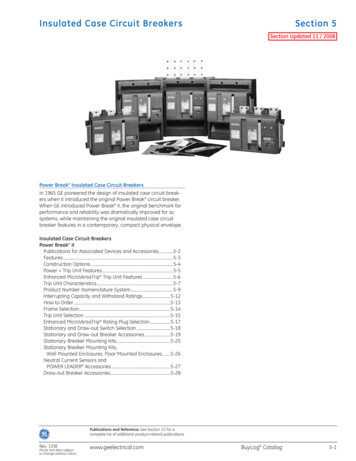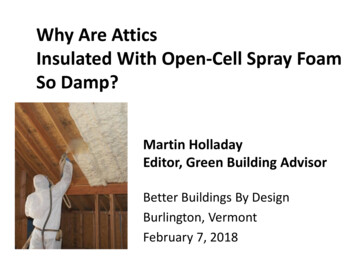
Transcription
Why Are AtticsInsulated With Open-Cell Spray FoamSo Damp?Martin HolladayEditor, Green Building AdvisorBetter Buildings By DesignBurlington, VermontFebruary 7, 2018
Learning objectivesUpon completion, participants will be able to: Design insulation details for an unvented conditioned atticthat will prevent moisture problems. Recommend remedies to reduce the chance of sheathing rotin unvented attics with high moisture levels. Identify the sources of moisture in unvented conditionedattics with elevated indoor humidity levels. Decide whether open-cell spray foam or closed-cell sprayfoam is preferable when creating an unvented conditionedattic.
CreditI’d like to credit Building Science Corporation forsome of the illustrations used in thispresentation.
The intersection of two topicsWe’re going to betalking about Attics and Spray foam
Attics In between spaces: neither inside noroutside Traditionally unconditioned, butincreasingly conditioned.
Attics are complicated
Spray foamTwo basic kinds of spray polyurethane foam: Open-cell spray foam (1/2 lb. per cubic foot)is vapor-permeable. Closed-cell spray foam (2 lbs. per cubic foot)is more or less vapor-impermeable.Both types of spray foam are air barriers.
Spray foam solves problemsSpray foam stops air leakage, unlike fiberglass
When attics are sealed, they turn damp Lots of homeowners areconverting vented atticsinto sealed attics byinstalling open-cell sprayfoam on the underside ofthe roof sheathing. Once the work is complete,the homeowners oftendiscover that their attic isdamp.
Why are they damp?Why? We don't know.
GBA readers report: “ higher than anticipated humidity in myattic ” “ very high humidity in the attic ” “The humidity shoots up into the 60s or 70s ” “I have a humidity problem in the attic ” “At the peak it's so damp that my glasses turnfoggy ”
A key questionWhere is the moisture coming from?
Find the moisture source Is it moisture from interior air?Is it moisture from exterior air?Could it be rain?Could it be dew?For example, perhaps the moisture enters theseattics in the summer through air leaks near thesoffits.
Let’s back up First, some history.
EDU article, April 2005Icynene dealers say,“You don’t need a vapor retarder.”
EDU article, July 2005Icynene insulation installed in Warren, Vermontis soaking wet.
Confusion about diffusionSome air barriers are vapor-permeable.
For example, canvas tents
Cold climate issues In cold climates, reports of damp sheathing dateback 15 or more years. Open-cell spray foam is vapor-permeable, so themoisture in interior air often diffuses through thefoam until it hits the cold sheathing. The solution to this problem (in theory)is to install a vapor retarder on theinterior side of the insulation.Illustration credit:Building Science Corp.
Vapor-retarder paint won’t workFor years, buildingscientists told builders topaint cured open-cell sprayfoam in attics with vaporretarder paint.The only problem with thisadvice is it doesn’t work.
What’s new here Now, we’re gettingreports of damp atticsin hot climates as wellas cold climates.Why?We don’t know.
Three expertsI interviewed: Joseph Lstiburek,Building Science Corp. William Rose, Universityof Illinois Iain Walker, LawrenceBerkeley National Lab.
Joe Lstiburek: Some history “Icynene took this idea to Florida. We created conditionedattics with low-density open-cell foam. That approachbecame a huge industry in South Florida.” When these attics had leaky ductwork, everything was fine. “When ductwork got tighter, we ended up with very highhumidity in the attics. We discovered sweating on the ductsand mold on the mastic.”
Leaky attic ductwork helpsLeaky ductwork helpsprotect OSB from gettingtoo damp. If a builderinstalls leaky ductwork ina sealed attic, the roofsheathing will probably bedryer than it would be ifthe ducts were wellsealed.
Leaky ductworkacts like an attic register Cool air in the summer and hot air duringthe winter was leaking out of the forcedair ductwork. While the leaks were unplanned, theyhelped condition the attic. Conditioned air is dryer thanunconditioned air.
But why were these attics damp?OK, leaky ductshelped.But why werethese attics dampin the first place?
Ping-pong moistureJoe Lstiburek and Kohta Ueno started callingthis attic moisture “ping-pong” moisture.
Is it inward solar vapor drive? An early explanation for thephenomenon of “ping pong”moisture was inward solarvapor drive through asphaltshingles. Lstiburek first championed,then abandoned, thisexplanation.Illustration credit:Building Science Corp.
The latest Lstiburek explanationLstiburek: “Moisture-laden air is lighter andless dense than dry air. Moisture-laden airends up in the attic due to this ‘hygricbuoyancy.’”
The moisture is stored in thesheathing and the foamLstiburek says that the moisture that causesthese problems is stored in the roof sheathingand in the foam itself. (Because roofsheathing gets cold at night due to nighttimeradiation cooling, it tends to absorb moistureevery night.) When the sun comes out, themoisture stored in the sheathing is driveninward, and the attic air becomes damp.
Kohta Ueno: Mostly in the sheathingKohta Ueno wrote, “We aretalking about the moisturestorage of the roof sheathingas the dominant storage, notthe foam itself. The foamstorage is variable based onclimate, elevation, andorientation, and tends to besmall — smaller in hotclimates, and larger in coldclimates.”
Problems don’t appear withclosed-cell spray foamSince closed-cell spray foam is a vapor barrier, itprotects the roof sheathing from this diurnal cycleof moisture storage and inward vapor drive.Illustration credit:Building Science Corp.
Bill Rose disagreesBill Rose is a research architect at theBuilding Research Council at the Universityof Illinois:“If we had a glass column as tall as a house,with a uniform temperature all around,then high school physics would perfectlyexplain the distribution of water moleculesin that glass column. There won’t be anystratification by molecular weight. Thereis fairly uniform mixing. That’s kinetictheory. That’s how gas molecules behave. The final, equilibrium, long-termcondition is always the mixed condition,with no stratification.”
Iain WalkerIain Walker is a staff scientist atLawrence Berkeley NationalLaboratory:“The folks at Oak Ridge NationalLab did some experiments with thistype of attic four years ago. Theydid some careful measurements.They found that indeed, it is humidin those attics. They are strugglingto figure out why.”
Probably not ‘hygric buoyancy’Iain Walker:“Like Bill, I’m not convinced of Joe’s hygricbuoyancy explanation. The answer probablyhas something to do with moisture goinginto and out of the wood and changes intemperature. The rates of the moisturegoing into the wood could be different fromthe rates of moisture coming out of thewood, allowing moisture to build up — akind of ratcheting.”
A problem without an answerIain Walker:“I don’t think wehave the rightexplanation yet. Thisis a problem inbuilding physics wedon’t yet have ananswer for.”
What about the spray foam industry?Joe Lstiburek: “Nowthe spray foampeople call menames. They aredenying they have aproblem, eventhough pretty mucheveryone knows thisis a problem.”
“Open to ideas”Rick Duncan, the technical director of the SprayPolyurethane Foam Alliance (SPFA):“We’re not pooh-poohing the issue. We’re opento ideas.”
Code issues: Fire safetySupply register plus return-air grille?“Why not alsorequire returnair?” Lstiburekasked. “Well, wewould need a codechange. Without acode change, thefire people’s headsexplode.”
Fire safety issues In most locations in a house, spray polyurethane foam — aflammable material — can’t be left exposed. It must be coveredby a thermal barrier — that is, 1/2-inch gypsum wallboard. Covering spray foam with drywall is expensive, and spray foamcontractors want to keep prices as low as possible. The solution:install a less stringent barrier (an ignition barrier) to save money.The most common type of ignition barrier is a type of paintcalled an intumescent coating. So far, so good. If you want to avoid the expense of coveringspray foam with drywall, the building code says you can — butonly in a certain type of attic. An ignition barrier is permitted ifthere is no easy access to the attic; if the attic isn’t used forstorage; if the attic has no floor; and if the attic air doesn’tcommunicate with the house air.
One possible solution:Cover the foam with drywallLstiburek:“The assumption behind the approval of the use ofintumescent coatings is that air from the attic doesnot communicate with the rest of the building. None of the International Code Council EvaluationService (ICC-ES) Evaluation Reports for spray foaminsulations allow this type of application if there is‘real’ air change or communication with the‘occupied space.’ Unless, the spray foam is coveredwith gypsum board. Cover the spray foam withgypsum board? Not going to happen.”
Code violations in conditioned atticsMany conditioned attics include code violations.Either:1. The local code inspector is looking the otherway, or2. The local code inspector is unfamiliar withcode requirements concerning ignitionbarriers.
Code says: No return ducts allowedReturn air ducts inthis type of attic aretechnically a codeviolation, whilesupply air ducts arein a kind of legalgray area.
Change the code? Lstiburek is now lobbying for a proposed codechange that would make it possible to providesupply air registers and return air grilles in thistype of attic. In his article “Cool Hand Luke Meets Attics,”Lstiburek wrote, “We can install a smoke detectorin the return duct that is coupled to air handlerand a fire alarm so that in the event of a fire thesystem is shut down. We need to codify this inthe Model Codes.”
An explanation may not matter Designers and builders don’t really care aboutthe ultimate resolution to this building sciencecontroversy. Designers and builders just want a strategy toprevent problems.
Advice for cold-climate buildersCold-climate builders who use open-cell sprayfoam have to worry about outward vapordiffusion during the winter. In Climate Zone 5and colder zones, water vapor in the indoor aircan diffuse through open-cell spray foaminstalled on the underside of roof sheathing.During the winter, when the sheathing is cold,the sheathing will accumulate moisture.
1. You need a vapor retarderTo prevent this type of risky moisture accumulation,cold-climate builders need to install a vapor retarderon the interior side of any open-cell spray foaminstalled on the underside of roof sheathing. Sincevapor retarder paint won’t work unless drywall is firstinstalled on the interior side of the closed-cell sprayfoam — and since installing drywall is expensive —most cold-climate builders avoid the use of open-cellspray foam in attics. Instead, they install closed-cellspray foam.
2. You need a forced-air registerLstiburek suggests that heating the attic duringthe winter, and air-conditioning the attic duringthe summer, can lower attic moisture levels.“Let’s require 50 cfm of supply air from theHVAC system per 1,000 square foot of attic.”
3. You might need drywall over the foamIf there is access to theattic via a stairway, or ifyou use the conditionedattic for a purpose otherthan storage, you needa thermal barrier (1/2inch drywall), not anignition barrier like anintumescent coating.
Always provide a forced-air registerLstiburek:“You can use open-cell low-density foam inattics both north and south. But they haveto be conditioned. Period. And in the norththe open-cell low-density spray foamneeds a vapor retarder.”
“Risky in all climate zones”A research paper called “A Hygrothermal RiskAnalysis Applied to Residential Unvented Attics”was authored by Simon Pallin, Manfred Kehrer,and William Miller.At a conference in Florida, Simon Pallin summedup the researchers’ findings this way: “Open-cellfoam [in attics] is risky in all climate zones.”
Expensive and possibly illegalWhile open-cell spray foam seems relativelyinexpensive, its use on the underside of roof sheathingmay require a protective layer of 1/2-inch drywall, aninterior vapor retarder, and special HVAC runs tocondition the air in the attic. Builders should considerthese costs before specifying open-cell spray foam. Onepossible solution to the humid-attic problem is toinstall a forced-air supply register (and perhaps areturn-air grille) in the attic. Note, however, that thissolution violates the building code unless the sprayfoam is protected by a layer of drywall.
Ventilation above open-cell foamIf a roof has simple geometryallowing soffit-to-ridge venting,one way to reduce the risk ofopen-cell spray foam is to installventilation baffles between theunderside of the roof sheathingand the open-cell spray foam. Thissolution won’t work, however, on ahip roof or a roof with valleys,dormers, or skylights.
Just use closed-cell spray foamConsidering the risks andhurdles I’ve described, I donot recommend theinstallation of open-cellspray foam on the undersideof roof sheathing in anyclimate. In this location,closed-cell spray foam ismuch less risky.
Other ways to insulatesloped roof assemblies Build a ventedassembly and usefluffy insulation Install rigid insulationabove the roofsheathing Use SIPs or nailbase
ThanksMartin Holladay, EditorGreen Building Advisormartin@greenbuildingadvisor.com
Cold climate issues In cold climates, reports of damp sheathing date back 15 or more years. Open-cell spray foam is vapor-permeable, so the moisture in interior air often diffuses through the
